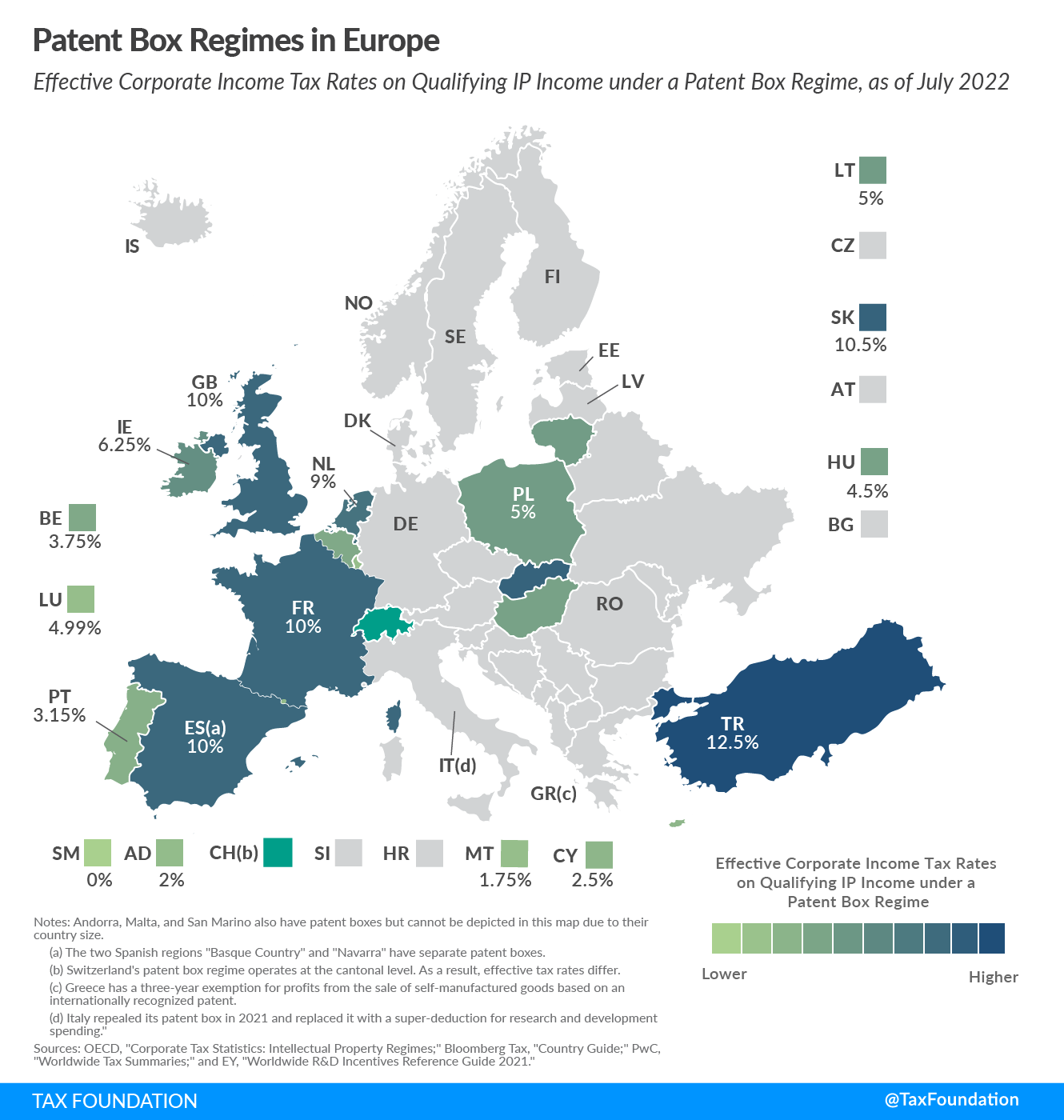As a 501(c)(3) nonprofit, we depend on the generosity of individuals like you. Help us continue our work by making a tax-deductible gift today.
The Tax Foundation is the nation’s leading independent tax policy nonprofit. Since 1937, our principled research, insightful analysis, and engaged experts have informed smarter tax policy at the federal, state, and global levels. For over 80 years, our goal has remained the same: to improve lives through tax policies that lead to greater economic growth and opportunity.
August 23, 2022
Daniel Bunn
Patent box regimes (also referred to as intellectual property, or IP, regimes) provide lower effective tax rates on income derived from IP. Most commonly, eligible types of IP are patents and software copyrights. Depending on the patent box regime, income derived from IP can include royalties, licensing fees, gains on the sale of IP, sales of goods and services incorporating IP, and patent infringement damage awards.
The aim of patent boxes is generally to encourage and attract local research and development (R&D) and to incentivize businesses to locate IP in the country. However, patent boxes can introduce another level of complexity to a tax system, and some recent research questions whether patent boxes are actually effective in driving innovation.
As today’s map shows, patent box regimes are relatively widespread in Europe. Most have been implemented within the last two decades.
Currently, 13 of the 27 EU member states have a patent box regime in place. These are Belgium, Cyprus, France, Hungary, Ireland, Lithuania, Luxembourg, Malta, Netherlands, Poland, Portugal, Slovakia, and Spain (federal, Basque Country, and Navarra). Non-EU countries Andorra, San Marino, Switzerland, Turkey, and the United Kingdom have also implemented patent box regimes.
The reduced tax rates provided under patent box regimes range from 0 percent in San Marino to 12.5 percent in Turkey.
Italy repealed its patent box in 2021 and instead introduced a deduction for 230 percent of costs related to research and development. This represents a transition from a benefit based on income (the patent box) to a benefit focused on investment or expenditure (the super-deduction).
Notes:
(a) “Other” refers to IP assets that are non-obvious, useful, and novel. These can only be applied to small and medium-size businesses.
(b) San Marino has two IP regimes. The “New companies regime provided by art. 73, law no. 166/2013” grants a tax rate of 8.5 percent. The “IP regime” grants a tax rate of 0 percent. Both apply to patents and software.
(c) The Spanish regions “Basque Country” and “Navarra” have separate corporate tax and therefore separate IP regimes.
(d) In 2020, Switzerland introduced a patent box regime at the cantonal level, which provides a maximum tax base reduction of 90 percent on income from patents and similar rights developed in Switzerland. Cantons can opt for a lower reduction.
(e) Turkey has a second IP regime which allows for a full tax deduction (0 percent effective tax rate) of qualified IP income resulting from R&D activities that were undertaken in Turkish Technology Development Zones.
Sources: OECD, “Dataset Intellectual Property Regimes”; Bloomberg Tax, “Country Guide”; PwC, “Tax Summaries”; EY, “Worldwide R&D Incentives Reference Guide 2022”; and OECD, “Tax Database: Table II.1. Statutory corporate income tax rate,” https://stats.oecd.org/Index.aspx?DataSetCode=TABLE_II1.
✔In 2015, OECD countries agreed on a so-called Modified Nexus Approach for IP regimes as part of Action 5 of the OECD’s Base Erosion and Profit Shifting (BEPS) Action Plan. This Modified Nexus Approach limits the scope of qualifying IP assets and requires a geographic link among R&D expenditures, IP assets, and IP income. To be in line with this approach, previously noncompliant countries have either abolished or amended their patent box regimes within the last few years.
Many European countries offer additional R&D incentives, such as direct government support, R&D tax credits, or accelerated depreciation on R&D assets. The effective tax rates on IP income can therefore be lower than the ones stated in the respective patent box regimes.
Subscribe to get insights from our trusted experts delivered straight to your inbox.
Share
Tweet
Share
Email
Confused about international tax proposals and rules like GILTI? Explore our latest research and analysis with our helpful guide.
Launch Resource Center
Stay up on the tax news and analysis that matters to you.
Get facts about taxes in your country and around the world.
The Tax Foundation is the nation’s leading independent tax policy nonprofit. Since 1937, our principled research, insightful analysis, and engaged experts have informed smarter tax policy at the federal, state, and global levels. For over 80 years, our goal has remained the same: to improve lives through tax policies that lead to greater economic growth and opportunity.
1325 G St NW
Suite 950
Washington, DC 20005